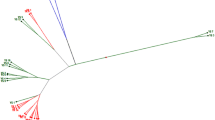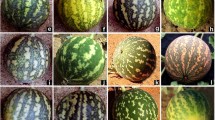Abstract
Smallanthus sonchifolius is a periennal herb originally cultivated in South America and now grown in several other countries. Recently, greater attention has been focused on this plant due to its agronomical, nutritional and pharmacological characteristics. In this paper the application of RAPDs and AFLPs for the analysis of genetic diversity in a group of 5 Smallanthus sonchifolius landraces is presented. Both methods proceed through the direct analysis of DNA, and their results were compared with the total phenolic content of each landrace and its morphological traits. Using 61 RAPD primers, 85 informative bands were identified, corresponding to 28.7% of polymorphism. In comparison, only six selected AFLP primer pairs produced 84 informative bands, with a similar percentage of polymorphism (23.4%). RAPD and AFLP markers were analyzed separately. Total phenolic content varied twofold among the five landraces analysed, ranging from 3,494 to 6,849 mg/g. Each type of molecular marker resolved two main groups that included the same genotypes, but with different within-group relationships among genotypes. The two groups are consistent with some phenotypic characters but they do not reflect faithfully their geographical origin. Most notably, the two groups comprise landraces with higher and lower total phenolic content, respectively. Dendrograms based on the two molecular data sets graphically depicted the ability of both methods to differentiate all the cultivars studied. Data obtained suggest that the two molecular markers applied are useful to investigate intra-specific genetic variability in Smallanthus sonchifolius, and predict well the total phenolic content of each landrace.



Similar content being viewed by others
References
Armstrong JS, Gibbs AJ, Peakall R, Weiller G (1994) The RAPDistance package ftp: life anu edu au/pub/software/RAPDistance or http://life anu edu au/molecular/software
Aybar J, Sanchez A, Grau A, Sanchez S (2001) Hypoglycemic effect of the water extract of Smallanthus sonchifolius (yacon) leaves in normal and diabetic rats. J Ethnopharmacol 74:125–132
Eldredge L, Balard R, Baird WV, Abbott A, Morgens P, Callahan A, Scorza R, Monet G (1992) Application of RFLP analysis to genetic linkage mapping in peaches. Hort Sci 27:160–163
Gao L, Wang S, Oomah BD, Mazza G (2002) Wheat quality: antioxidant activity of wheat millstreams. In: Ng P, Wrigley CW (eds) Wheat quality elucidation. AACC International, St. Paul, MN, pp 219–233
Grau A, Rea J (1997) Yacon Smallanthus sonchifolius (Poepp et Endl.) H Robinson. In: Hermann M, Heller J (eds) Andean roots and tubers: ahipa arracacha maca yacon promoting the conservation and use of underutilized and neglected crops. 21 Institute of Plant Genetics and Crop Plant Research Gatersleben/International Plant Genetic Resources Institute Rome, Italy, pp 199–242
Karp A, Seberg O, Buiatti M (1996) Molecular techniques in the assessment of botanical diversity. Ann Bot 78:143–149
Lin F, Hasegawa M, Koodama O (2003) Purification and Identification of antimicrobial sesquiterpene lactones from Yacon (Smallanthus sonchifolius) leaves. Biosci Biotechnol Biochem 67:2154–2159
National Research Council (1989) Lost crops of the Incas: little-known plants of the Andes with promise for worldwide cultivation/report of an ad hoc panel of the advisory committee on technology innovation. Board on Science and Technology for International Development, NRC Washington, DC, USA, pp 114–123
Simonovska B, Vovk I, Andresek S, Valentova K, Ulrichova J (2003) Investigation of phenolic acids in yacon (Smallanthus sonchifolius) leaves and tubers. J Chromatogr 1016:89–98
Singleton VL, Rossi JA (1965) Colorimetry of total phenolics with phosphomolybdic-phosphotungstic acid reagents. Am J Enol Vitic 16:144–158
Acknowledgments
I would to thank Prof. Pasquale Piazolla that gave me the opportunity to work in this laboratories abroad.
Author information
Authors and Affiliations
Corresponding author
Additional information
This work represents the first report of the contemporary use of RAPD and AFLP markers on a yacon genome, and the first to correlate genetic differences with landrace total phenolic content.
Rights and permissions
About this article
Cite this article
Milella, L., Martelli, G., Salava, J. et al. Total phenolic content, RAPDs, AFLPs and morphological traits for the analysis of variability in Smallanthus sonchifolius . Genet Resour Crop Evol 58, 545–551 (2011). https://doi.org/10.1007/s10722-010-9597-x
Received:
Accepted:
Published:
Issue Date:
DOI: https://doi.org/10.1007/s10722-010-9597-x




